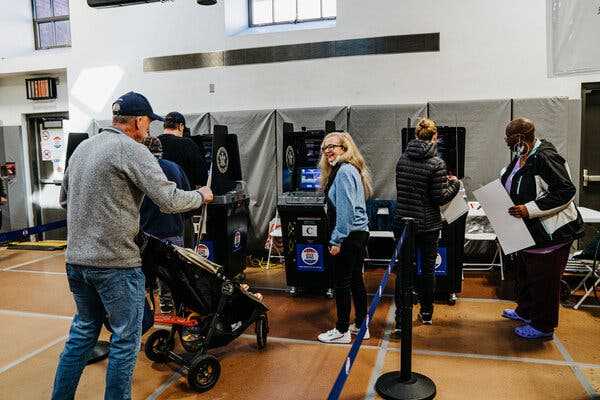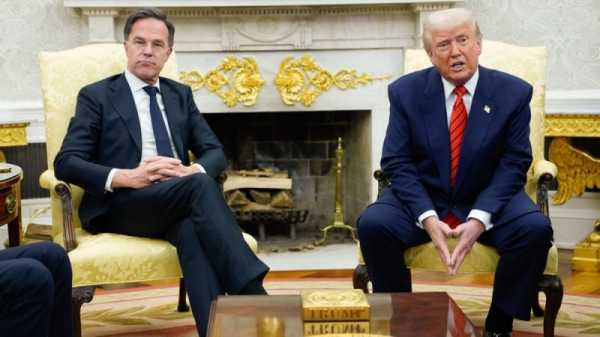It’s a unique midterm year, with a Republican-friendly environment, an abortion ruling energizing Democrats, and increased partisanship in how people cast ballots.
-
Send any friend a story
As a subscriber, you have “>10 gift articles to give each month. Anyone can read what you share.
Give this articleGive this articleGive this article

Voters in Brooklyn last week during the first day of early voting. As of Tuesday afternoon, nearly 26 million early ballots had been cast nationwide.
WILLOW GROVE, Pa. — It’s the biggest mystery of the midterms: Which groups of voters will turn out in the largest numbers?
It’s also, obviously, the most important question of all. Most, if not all, of the big Senate races are within what political pros call the “margin of field” — meaning that a superior turnout operation can mean the difference between winning and losing.
“It’s the only thing that matters right now,” said Molly Parzen, the executive director of Conservation Voters of Pennsylvania, an environmental group that is part of a coalition of liberal organizations running get-out-the-vote operations in the state.
On a sunny day here in mostly Democratic suburban Philadelphia, I tagged along as Parzen’s group plowed through its file of middle-class voters in the town where Jill Biden spent some of her early years. It’s painstaking work, knocking on doors and gently nudging people to vote for Josh Shapiro and John Fetterman in Pennsylvania’s heated races for governor and Senate.
Parzen said the races seemed even tighter to her than the public polls indicated. And the handful of voters in this blue-collar area who indicated that Fetterman wouldn’t win their vote — one older white man, echoing millions of dollars’ worth of negative ads from Republicans, said he wanted to “strangle him with his bare hands” over his perceived views on crime — suggested that the Senate race was worth watching closely.
Nationally, we already have some data on the early votes cast so far — nearly 26 million as of Tuesday afternoon — but interpreting what the numbers mean is always something of an art. And this year, it’s more confusing than ever.
For instance: Does the relatively low turnout of younger voters so far mean they aren’t enthusiastic about voting? Or does it mean they are reverting to their usual, prepandemic habit of voting on Election Day? Is there some more prosaic explanation, such as that colleges only recently started rolling out drop boxes on campus?
Will there indeed be a surge of newly registered voters angered by the Supreme Court’s abortion decision, as some Democrats argue? Have pollsters corrected for the errors they made in 2020, when many of them overestimated Democrats’ eventual support? Or have they overcorrected?
Almost universally, strategists confess befuddlement and uncertainty about an election that has shaped up somewhat differently than most, with the issue of abortion rights energizing Democrats and putting Republicans into a defensive crouch in many states.
Republicans tend to be more confident that widespread public frustration over inflation will propel them to victory, regardless of the problems that have dogged them, like weak fund-raising and Senate candidates their own leaders have described as low in “quality.”
The State of the 2022 Midterm Elections
Election Day is Tuesday, Nov. 8.
- A Pivotal Test in Pennsylvania: A battle for blue-collar white voters is raging in President Biden’s birthplace, where Democrats have the furthest to fall and the most to gain.
- Governor’s Races: Democrats and Republicans are heading into the final stretch of more than a dozen competitive contests for governor. Some battleground races could also determine who controls the Senate.
- Biden’s Agenda at Risk: If Republicans capture one or both chambers of Congress, the president’s opportunities on several issues will shrink. Here are some major areas where the two sides would clash.
- Ohio Senate Race: Polls show Representative Tim Ryan competing within the margin of error against his G.O.P. opponent, J.D. Vance. Mr. Ryan said the race would be “the upset of the night,” but there is still a cold reality tilting against Democrats.
Democrats in particular are puzzling over the decision Republicans made during the pandemic to demonize mail-in and early voting, after years of dominating the practice in states like Arizona and Florida. In some states, Republican Party officials have quietly sent out mailers or digital ads urging their supporters to vote early, but more prominent Republican politicians dare not amplify those appeals — lest they be on the receiving end of a rocket from Donald Trump.
It has often fallen to conservative outside groups, like Turning Point Action, to rally voters. The group, which is run by the controversial pro-Trump activist Charlie Kirk, is holding a get-out-the-vote event on Saturday in Phoenix.
“When you’ve convinced your base that it’s a fraudulent method of voting, you have very little room to change their minds this late in the game,” said Tom Bonier, the chief executive of TargetSmart, a Democratic data firm. “There are so many things that can go wrong on Election Day.”
Fast-changing campaign innovations
Get-out-the-vote operations became objects of media fascination after Barack Obama’s 2008 victory, which capitalized on new ways of organizing volunteers, sophisticated social-science techniques and innovative social media strategy to run circles around John McCain’s more traditional operation.
That led many Democrats to presume that they had an edge over Republicans in the art and science of campaigns — but Trump’s upset defeat in 2016 of Hillary Clinton, whose data and field operations were widely panned afterward by fellow Democrats, upended the conventional wisdom on that score. Fieldwork, never glamorous, has not had the same cachet since.
“My assumption on everything is that Republicans are at least as good as Democrats in everything they’re doing,” said David Nickerson, a political scientist who worked on Obama’s campaign and studies turnout.
“People adjust to innovations really quickly,” he added, “and if you do find one, it’s not going to last.”
In one example that is famous among turnout specialists, George W. Bush’s 2000 campaign was stunned by Al Gore’s closing surge. Four years later, Karl Rove, Bush’s political guru, responded with a “72-hour plan” in the final days of the 2004 campaign that is widely credited for helping defeat John Kerry.
But much has changed since the early 2000s, and lessons learned back then might not apply today. As money has flooded into political campaigns, Americans have become inundated with television ads, campaign fliers, social media posts and digital ads.
People also follow politics much more closely than they did back then, even if there’s more noise competing for their attention.
“It’s like sports now, dude,” said Ian Danley, a Democratic organizer in Arizona.
Who’s got the best ground game?
Campaigns love to boast about their “ground games,” whether it’s to feed the notebooks of information-hungry reporters or to motivate their own troops.
In Arizona’s races this year, for instance, both parties claim to have the superior field operation. Senator Mark Kelly is relying on Mission for Arizona, the Democrats’ statewide coordinated campaign apparatus. That effort began in June 2021, the earliest Democrats have done so in Arizona. Democrats in Arizona also have an independent organizing effort run by a coalition of unions and progressive groups, which has led to occasional tensions.
Infighting on the Republican side has made a parallel effort harder. The Republican Governors Association, for instance, has funneled its support for Kari Lake, the party’s nominee for governor, through the Yuma County Republican Party, rather than the state party. And while Kelly’s campaign is stocked with veterans of his 2020 victory, his opponent, Blake Masters, has run a bare-bones operation that has relied heavily on the support of an allied super PAC.
“We are running an incredibly lean field operation, and it’s all internal to the campaign,” said Amalia Halikias, the campaign manager for Masters. “We are knocking on doors that often go overlooked: Democrat doors, low-propensity voters and people who have never voted before.”
Democrats return to the doors
Veteran operatives say that get-out-the-vote practices like knocking on doors are even more important in midterm elections than they are in presidential campaigns.
The reason? Turnout in midterms is usually around 20 percentage points lower than in presidential years, meaning that the tricks and tools campaigns use to persuade, cajole and nudge people to turn in their ballots or head to the polls become more crucial.
Door-knocking, for instance, is about three to four times more effective in a midterm election than it is in a presidential election, Nickerson said, because during a presidential year, more voters are paying attention and are already planning to vote.
ImageA Democratic Party office in Eau Claire, Wis., after a canvassing event last month.Credit…Liam James Doyle for The New York Times
In 2020, Democrats and their allies mostly stayed away from door-knocking because of the pandemic. They’re back out in force now, though some turnout-focused groups in Georgia have complained that donor fatigue has left them with fewer resources than in 2020.
But assuming Democrats can roughly reach parity with Republicans this year, it could help neutralize what was a G.O.P. advantage during Trump’s re-election bid. Face-to face conversations are widely understood to be the most effective way to reach voters.
According to Daron Shaw, a former George W. Bush campaign strategist who now studies turnout at the University of Texas, a good rule of thumb is that for campaigns, every 100 face-to-face contacts made are likely to yield 9 votes. In other words, a campaign that contacts 1,000,000 potential voters will nudge 90,000 of them to cast ballots for the candidate in question.
Both parties expect the G.O.P. to rely heavily on a surge of Election Day turnout, while Democratic campaigns are furiously banking as many early votes as they can. That approach gives them a tactical advantage, Democrats say: It lets them work through their voter contact files and adjust their targeting on the fly, whereas Republicans in many states will have to trust that their models are accurate.
All of these tactical advantages might make a difference only on the margins of a tight Senate or House race, though.
Turnout is also driven by big-picture issues and trends, and those are not working in Democrats’ favor. In 2018, it was Democrats angered by Trump’s presidency who swamped Republicans and took back dozens of House seats. This year, Nickerson said, “for Republicans, it’s how mad are you about Biden and the economy?”
Image
What to read
-
Top Democrats are openly second-guessing their party’s campaign pitch and tactics, worrying about a failure to coalesce around one effective message for the midterms, Lisa Lerer, Katie Glueck and Reid Epstein report.
-
Representative Liz Cheney and other Republican opponents of Donald Trump are stepping up their efforts to thwart a comeback of his political movement, Jonathan Weisman writes.
-
Adam Laxalt, the Republican nominee for Senate in Nevada, could easily be mistaken as a legacy candidate, with a grandfather who was once a governor and senator in the state. But he has shed much of his political inheritance, positioning himself as a child of the Trump era, Matthew Rosenberg writes.
Image
Thank you for reading On Politics, and for being a subscriber to The New York Times. — Blake
Read past editions of the newsletter here.
If you’re enjoying what you’re reading, please consider recommending it to others. They can sign up here. Browse all of our subscriber-only newsletters here.
Have feedback? Ideas for coverage? We’d love to hear from you. Email us at [email protected].
Image
Source: nytimes.com



